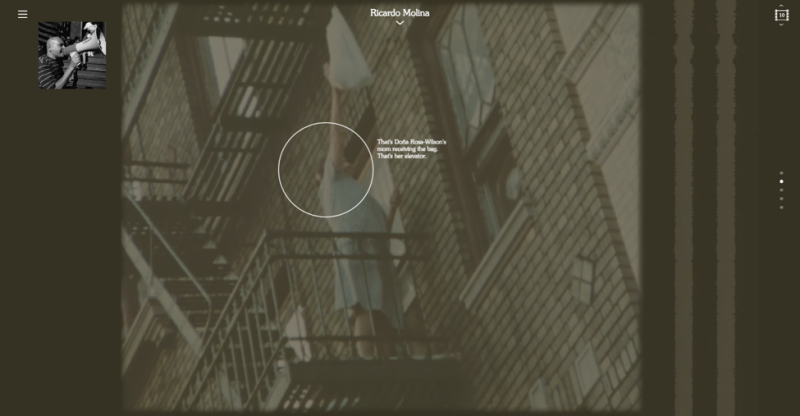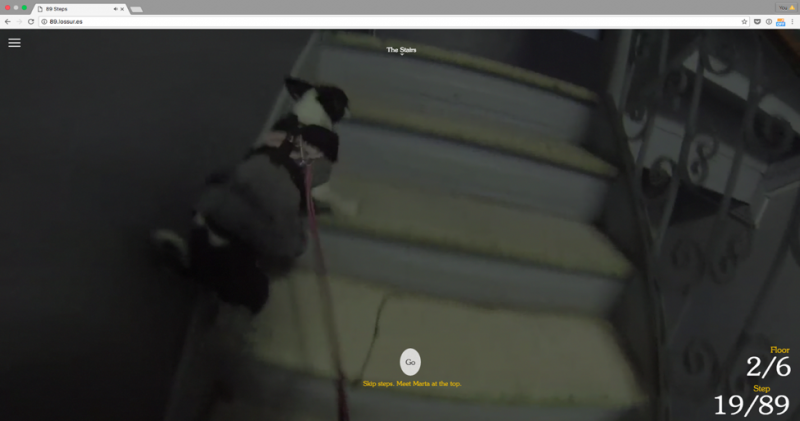by Sara Rafsky
Living Los Sures is a multimedia, expansive documentary project that responds to Diego Echeverria’s 1984 documentary Los Sures, a cinema vérité portrait of South Williamsburg, New York, and the largely Puerto Rican and Dominican communities that lived there. Produced over five years by 60 artists at UnionDocs Center for Documentary Arts in Williamsburg, the project includes an interactive documentary, a collection of short films that look at how the neighborhood has changed, and a “cinematic people’s history” in the form of a shot-by-shot analysis of the film by its subjects and local community members.
HISTORY OF THE PROJECT
For over a decade, UnionDocs has operated as a center for documentary filmmaking in the ever-changing neighborhood of Williamsburg in Brooklyn, witnessing firsthand the ongoing gentrification process and ensuing frictions it has caused in the community. Conscious of these tensions, UnionDocs founder Christopher Allen was instantly intrigued when local filmmakers Pamela Yates and Paco de Onis mentioned that a friend of theirs had made a documentary about the neighborhood back in the 1980s. A bootleg VHS copy was delivered days later and Allen said he was “completely blown away’ after watching the film, setting in motion the rediscovery and celebration of a long-forgotten gem of documentary cinema vérité and the creation of the wider interactive project.
In addition to organizing a series of local screenings and then a later successful theatrical release of the painstakingly restored film, Allen said it was clear to him and his UnionDocs staff that Los Sures offered a number of possibilities for deeper engagement and further projects as part of the center’s Collaborative Studio residency program. While the project evolved over five years and grew in scope and ambition, it was “always related to the discovery of the original,” Allen said.
After exploring various ideas which were developed through participation in several hackathons, Living Los Sures eventually took shape as three separate, but related projects.
SHOT-BY-SHOT
 The starting frame of the 212th shot of Echeverria’s Los Sures.
The starting frame of the 212th shot of Echeverria’s Los Sures.
Image Courtesy of UnionDocs.
Shot-by-Shot evolved out of the desire to use the film as the launching pad for an interactive, participatory project involving the recollections of the remaining members of the community from the Los Sures era. After a series of experimentations, Allen and his team decided to literally “deconstruct the edit,” incorporating those memories as annotations onto the narrative of the film, down to each individual shot.
The process of assembling these reminiscences was a long-term, community-wide effort involving local organizations, Facebook groups and word-of-mouth amplification to bring together the over 100 people who contributed. After some trial and terror interview techniques, UnionDocs staff eventually sat down with each of these people individually and recorded their thoughts as they watched a series of shots loop silently. “Not only were they able to identify so much of the detail in sort of the margins of the frame from people, places and things, and sights in the background,” Allen said, “but also it returned this flood of memories to them… it was very emotional for a lot of people to experience.”
As a design experience, Allen and his staff had to evolve from a database model to more of a scroll-based one, where the user could jump to anywhere in the film’s catalogue of 326 shots. Each shot has its own page where the user is introduced to a series of stories and images and videos related to what was shown in that shot. Using a WordPress back-end and a “fancy” JavaScript front end, an intermediary pulls the relevant material out of a database that is translated into a front-end experience. The original shot plays first with sound and then loops silently in the background as the collected stories and media appear in the foreground in a linear interface that the user can scroll through. The resulting effect is somewhat akin to watching a hyper-dense multimedia collage assemble and dissemble before your eyes. Each new layer builds upon or unpacks some detail of the original film or adds an unexpected contemporary image, commentary or comparison that scrolls or swipes across the screen. In total, the UnionDocs team collected at least 500 elements or “stories” that were incorporated into the film’s 326 shots.
 Index of Living Los Sures: Shot by Shot.
Index of Living Los Sures: Shot by Shot.
Image courtesy of UnionDocs
In some cases, contemporary Google Street Views of the exterior locations shown in the film appear as a side-by-side comparison with the shot, often with narratives or commentary about the site today. These were made with the help of an intern and aspiring local documentary filmmaker who carefully identified each of the 200 locations and are shown with custom-made tools created by Allen and his team to mimic the original camera angles.
Some of the stories reference specific, visible details in the individual shot. In these cases, Allen and his team used an x-y coordinate identifier, paired with a timestamp, that highlighted a piece of the frame around which a circle would later be drawn. If the story referred to a specific moment, rather than detail, a loop editor function allows a portion of the shot to be selected to loop whiles the related story is being shown. If the commentary or annotation mentioned a line of dialogue rather than visual cue, a highlighted portion of the scanned, original typewritten script of Los Sures appears as a photo slide.
 Example of a highlight in Living Los Sures: Shot by Shot.
Example of a highlight in Living Los Sures: Shot by Shot.
Image courtesy of UnionDocs
89 STEPS
The interactive online documentary 89 Steps reintroduces the viewer to Marta Aviles, one of the protagonists of the original film. In Los Sures, Aviles appears as a single mother living with her five children on welfare. Thanks to the owner of a bodega across from the street from UnionDocs who immediately recognized her from a 30-year old photograph, Allen and his team reconnected with Aviles, now in her 60s, at a delicate moment in which she was thinking about leaving the neighborhood. One of the factors, among others, motivating this move was the six flights of stairs she had to walk up every day to reach her apartment – the same flights of stairs which she memorably descends with her children in one scene in the original film. “We thought of the stairs as both the space for character development and the introduction of the conflict,” Allen said.
As the viewer clicks on his or her mouse, he or she ascends the stairs along with Aviles and her dog, embodying her POV as she narrates in voice-over her history in the neighborhood, pausing every now and then to add an encouraging “you’re almost there. Should we stop to take a breath?” Once reaching the top, the viewer can click through for a 360 degree-view of the apartment. An additional chapter plays with the very New York City genre of real estate as narrative, as the viewer explores the realtor listing to sell her apartment which intersperses clips from the film that occurred in the various spaces and rooms.
 Still from chapter 2, The Stairs, of 89 Steps.
Still from chapter 2, The Stairs, of 89 Steps.
Image Courtesy of UnionDocs
To create this dynamic, the UnionDocs team incorporated strategies for interactivity into the production of the film, rather than create the elements later in post-production. This included shooting scenes from multiple angles and phrasing questions to Marta in ways that would facilitate the voice-over. Afterwards, they sought to incorporate looping video clips with several different position-specific layers of audio in a way that felt seamless. The complex process, Allen wrote in a case study for i-DOCS, involved “pushing the envelope” of HTML5 audio with programs like popcorn.js and howler.js and allowing for the browser-mandated specificities of the various audio and video file types.
Over the course of two Mozilla-sponsored hackathons, the team was able to work with developers to make prototypes that would allow the narrative to unfold with linearity but also various interactive challenges, using Marta’s voice-over narration as guidance. “Almost like she’s looking over your shoulder,” Allen said.
SOUTHSIDE SHORT DOCS
The final component of the project is comprised of a series of 40 short films that were made over the course of several years with successive groups of fellows from UnionDoc’s Collaborative Studio. The ten-month residency allowed the teams of filmmakers to research, develop and produce the short documentaries, which were intended to respond in some way to and be inspired by the original film and the present-day life of the neighborhood it depicts. The films, which have been exhibited locally and in festivals and museums around the world, range in subject matter from depicting the last remaining local Latino social club, the fights against charter schools and an animated oral history.
UnionDocs and the local community organization El Puente, Allen writes, have partnered to build a pilot curriculum for youth that uses both Los Sures and the broader Living Los Sures project to teach about local issues, media literacy, and documentary.
0 comments